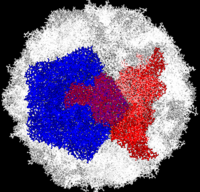Antiviral Activity of 3(2H)- and 6-Chloro-3(2H)-Isoflavenes against Highly Diverged, Neurovirulent Vaccine-Derived, Type2 Poliovirus Sewage Isolates
Lester M. Shulman, Danit Sofer, Yossi Manor, Ella Mendelson, Jean Balanant, Anna Laura Salvati, Francis Delpeyroux, Lucia Fiore[1]
Molecular Tour

Complete Poliovirus 2 Virion (capsid) based on PDB entry
1eah,
example of 3-fold symmetry is in red,
example of 5-fold symmetry is in bluePoliovirus is a member of the Picornaviridae. Like other members of the Picornaviridae, poliovirus RNA is encapsulated in an icosahedral structure (see the static image at the left or ) formed from 60 with axes of and symmetry. So, in formation of . of viral capsid proteins VP1 (light blue), VP2 (pale green), VP3 (light orange) and VP4 (light magenta). The binding site for the human poliovirus receptor is located . The VP1 of picornaviruses contain a . This pocket is normally occupied by pocket factors, sphingosine-like molecules including palmitic and and hydrophobic compounds, that stabilize the capsid and whose removal is a necessary prerequisite for uncoating. The (1eah). SCH48973 forms predominantly hydrophobic interactions with the pocket residues. Flavanoids and flavonoids were shown to have antiviral activity in vitro against several picornaviruses including type 2 polioviruses. These compounds act primarily by occupying the hydrophobic pocket, thus interfering with virus uncoating. Compounds and 6-chloro-3(2H)-Isoflavene (C10) are relatively similar to and exert their antiviral effect by interacting with amino acids in the viral capsid pockets. Ambiguous vaccine-derived poliovirus 2 (aVDPV) isolate was resistant to the antiviral effects of both C2 and C10 compounds. The in silico translated amino acid sequences of the capsid proteins of all of the aVDPV2 isolates and Sabin 2 (AY184220) were compared and amino acid substitutions in capsid proteins that were unique to SD-06-10 were determined. The positions of these unique substitutions were mapped onto the coordinates of type 2 poliovirus (1eah) using PyMOL and . The hydrophobic pocket is represented by blue spheres and the position of amino-acid substitutions that were previously shown to result in loss of sensitivity (yellow) to or dependence on isoflavenes are indicated by the yellow and green spheres, respectively. One unique substitution at of symmetry and another .
The positions of unique substitutions of SD-07-03 was also determined and were mapped onto the coordinates of type 2 poliovirus and .
The hydrophobic pocket is represented by blue spheres and the position of amino acid 143 of VP1, one of two determinants for neurovirulence in type 2 poliovirus is represented by orange spheres. The colors are as in the previous scenes. . Unique substitutions found in SD-07-03 at . None of SD-0703’s unique substitutions were located near the 3-fold axis of symmetry.


